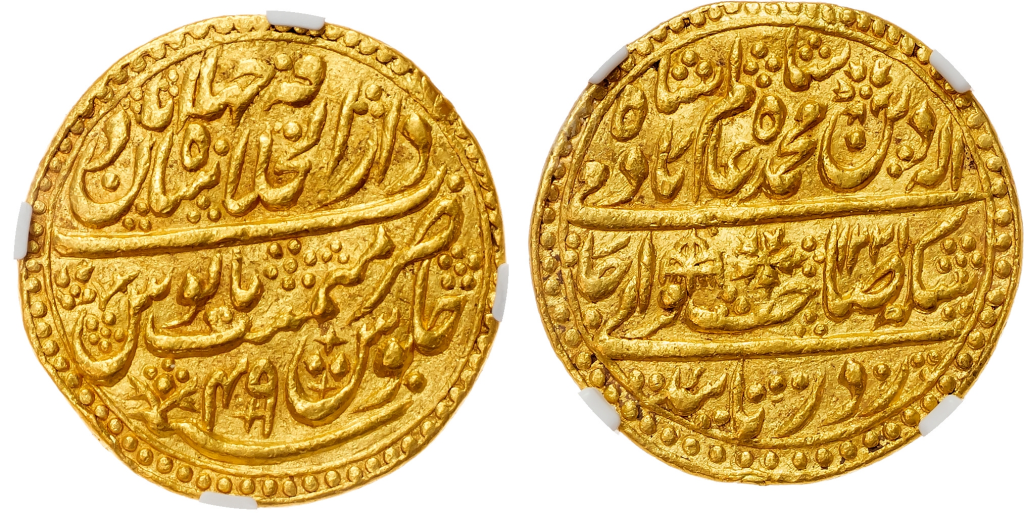The Gold Nazarana Mohur of Shah Alam II (1759–1806 AD) is a breathtaking artifact from the waning days of the Mughal Empire—a time of political turmoil, shifting alliances, and imperial decline. Despite the empire’s fading power, Mughal coinage still retained its grandeur and elegance, and this Nazarana Mohur is a testament to that.

What is a Nazarana Mohur?
The Nazarana Mohur was not an ordinary circulation coin but rather a presentation piece, struck in pure gold and given as a gift to nobles, foreign dignitaries, and members of the imperial court. These coins symbolised loyalty, wealth, and prestige, often produced in limited quantities, making them incredibly rare today.
Design & Symbolism
Shah Alam II’s Nazarana Mohurs bore intricate Persian calligraphy, featuring his full imperial titles on the obverse, declaring his divine right to rule. The reverse often displayed a beautifully stylised inscription of the mint name, date, and regnal year, following the tradition of Mughal coinage. Some versions carried floral patterns or decorative borders, reflecting the refined artistic traditions of the Mughal court.
A Unique Coin in a Fading Empire
By the time Shah Alam II ascended the throne in 1759, the Mughal Empire was little more than a shadow of its former self. He ruled in name only, as the empire had been fractured by Marathas, Afghans, and the British East India Company. In 1765, after being blinded by the forces of the Afghan warlord Ghulam Qadir, he became a puppet ruler under British influence. Yet, despite his powerlessness, coins like the Nazarana Mohur continued to be struck, carrying the grandeur of an empire that once ruled the entire Indian subcontinent.
A Crazy Story About Shah Alam II: The Blinded Emperor
Shah Alam II’s life was filled with misfortune, but his worst ordeal came in 1788, when the ruthless warlord Ghulam Qadir stormed Delhi and took him captive. In a shocking display of brutality, Ghulam Qadir tortured the emperor for days and gouged out his eyes, making him completely blind. Yet, despite his suffering, Shah Alam II outlived his captor—the Marathas later executed Ghulam Qadir and restored the emperor to the throne as a British vassal.
Numismatic Legacy
This unique Nazarana Mohur, likely one-of-a-kind, represents the last echoes of Mughal prestige before the British tightened their grip on India. It is an extraordinarily rare coin, not just because of its limited mintage but because it embodies a dynasty in decline, holding onto its majestic traditions even as its empire crumbled.
#MughalCoins #ShahAlamII #NazaranaMohur #GoldMohur #IndianNumismatics #RareCoins #AncientCoins #BritishRaj #MughalHistory #CoinCollecting #HistoryLover #LostEmpire


